Characterizing CO2 Emission from Various PHEVs Under Charge-Depleting Conditions
Abstract
1. Introduction
2. Materials and Methods
2.1. Test Equipment
2.2. Test Vehicles
2.3. Test Route
2.4. Data Processing
3. Results
3.1. Test Cycles
3.2. The Variation of CO2 Emissions on Different Road Types
3.3. Investigating the Impact of Driving Characteristics on CO2 Emission Rates
3.3.1. Examining the Impact of VSP on CO2 Emission Rates
3.3.2. Evaluating the Effect of Speed and Acceleration on CO2 Emission Rates
3.4. Quantifying CO2 Emission Factors Based on Distance for Different PHEVS
3.4.1. Assessment of Emission Factors on Various Road Types
3.4.2. Evaluation of CO2 Emission Factors in Different VSP Intervals
4. Conclusions
- (1)
- In this study, we conducted RDE tests on S-HEV, SP-HEV, and P-HEV. During the tests, the vehicle batteries were discharged to the minimum charge limit specified by the manufacturers. The research findings indicate that there is a correlation between acceleration and the increase in CO2 emission levels of P-HEV. However, acceleration has a relatively minor impact on the CO2 emissions of the S-HEV and SP-HEV. Under urban driving conditions, the SP-HEV exhibited the lowest average CO2 emission rate, which was 20.94% lower than that of the P-HEV and 80.69% lower than that of the S-HEV. In contrast, under suburban and highway driving conditions, the average CO2 emission rates of the three vehicle types followed the pattern of S-HEV > SP-HEV > P-HEV. Specifically, the CO2 emission rate of S-HEV was 22.77% to 40.96% higher than that of SP-HEV and 49.14% to 86.75% higher than that of P-HEV.
- (2)
- The experimental results demonstrate that for S-HEV across three road types, the CO2 emission rate changes relatively little with an increase in VSP. Moreover, when driving at low speeds (<20 km/h) in urban areas, S-HEVs can fully utilize their electric drive systems, resulting in nearly negligible CO2 emission rates. However, once the vehicle speed exceeds 20 km/h, the emission rate rises significantly as the demand for power increases. For SP-HEVs, the CO2 emission rate increases with VSP during urban driving but remains relatively stable during suburban and highway driving. Additionally, SP-HEVs exhibit lower emission rates when the deceleration exceeds 0.5 m/s2 in suburban areas or 0.8 m/s2 on highways, indicating good emission control performance during deceleration. For P-HEVs, the CO2 emission rate is significantly influenced by VSP across all three road types, rising with an increase in VSP. Nevertheless, their emission rates are also almost zero at low urban speeds (<20 km/h) and remain lower when the acceleration is less than 0.3 m/s2 or during deceleration, showcasing their low-emission advantages under low-acceleration and deceleration conditions. Therefore, it is recommended that drivers avoid aggressive driving behaviors to reduce high-VSP operating conditions, thereby lowering CO2 emissions and ultimately improving urban air quality. Although directly monitoring individual driving behaviors in real time is challenging, the following measures can be taken to facilitate progress: Automobile manufacturers can install feedback systems in vehicles, enabling drivers to stay informed in real time about their driving styles and the impact on carbon dioxide emissions, thereby guiding them toward eco-friendly driving. Traffic management authorities can utilize traffic monitoring facilities to analyze traffic flow patterns, identify areas with a high incidence of aggressive driving, and carry out targeted publicity and education campaigns or implement traffic management interventions.
- (3)
- Under different road types and corresponding VSP ranges, the CO2 emission factors of the three hybrid vehicles exhibit specific patterns: when VSP ≤ 0 on urban roads, VSP ≤ 5 on suburban roads, and VSP ≤ 15 on highways, the order of CO2 emission factors is S-HEV > SP-HEV > P-HEV, indicating that P-HEV performs best in controlling CO2 emissions within these low VSP intervals. The CO2 emission factors of P-HEV increase with rising VSP across all three road types. When VSP exceeds thresholds of 5 on urban roads, 15 on suburban roads, and 20 on highways, the emission factors of P-HEVs will surpass those of S-HEVs and SP-HEVs, demonstrating a weakening of their emission control capability. For SP-HEVs, the CO2 emission factors rise with increasing VSP on urban and suburban roads, but stabilize on highways, indicating relatively stable control over CO2 emissions on highways and the ability to adapt to higher VSP conditions to a certain extent. In contrast, the CO2 emission factors of S-HEVs do not change significantly with VSP variations across all three road types, showing relatively stable emission characteristics but a relatively average emission control capability that does not exhibit the distinct advantage of P-HEVs in low VSP intervals.
- (4)
- This study has several limitations. Firstly, the sample is confined to three common types of PHEVs, potentially failing to fully represent all PHEV models due to the vast diversity in their designs across brands. Secondly, the driving routes, while covering urban, suburban, and highway conditions, omit special scenarios like mountainous and extremely congested roads, which may lead to deviations when applying results to other situations. Thirdly, the research is temporally constrained as it does not account for seasonal and weather impacts on CO2 emissions, which can vary significantly between winter and summer.
Author Contributions
Funding
Institutional Review Board Statement
Informed Consent Statement
Data Availability Statement
Conflicts of Interest
References
- Lv, Z.; Guo, J.; Mao, H.; Dong, Y. Comparative analysis of energy flow and emissions in electric and engine-driven modes of a plug-in hybrid electric vehicle. Appl. Therm. Eng. 2025, 274, 126735. [Google Scholar] [CrossRef]
- Chen, J.; Wang, K.; Yu, H.; Chen, H.; Zhao, F.; Yu, W. A novel VSP-based CO2 emission model for ICEs and HEVs based on internally observable variables: Engine operating speeds. Energy 2024, 313, 133892. [Google Scholar] [CrossRef]
- Jeong, J.W.; In Lee, D.; Woo, S.; Lim, Y.; Lee, K. Analysis of energy consumption efficiency and emissions according to urban driving of hybrid electric vehicles in Korea. Appl. Energy 2024, 371, 123686. [Google Scholar] [CrossRef]
- Karjalainen, P.; Leinonen, V.; Olin, M.; Vesisenaho, K.; Marjanen, P.; Järvinen, A.; Simonen, P.; Markkula, L.; Kuuluvainen, H.; Keskinen, J.; et al. Real-world emissions of nanoparticles, particulate mass and black carbon from a plug-in hybrid vehicle compared to conventional gasoline vehicles. Environ. Adv. 2024, 15, 100454. [Google Scholar] [CrossRef]
- Li, B.-W.; Chen, Z.-H.; Zhu, X.-H.; Zhang, Z.; Peng, Z.-R.; Zhao, H.-M.; He, H.-D. Assessment of eco-driving strategies on carbon emissions for hybrid vehicles through portable emissions measurement systems. Atmos. Pollut. Res. 2025, 16, 102365. [Google Scholar] [CrossRef]
- Suthar, C.; Sangiri, J.B.; Maiti, S.; Chakraborty, C. A Pulse density modulated LLC resonant converter based battery charger for HEV/PHEV application. In Proceedings of the 2019 IEEE International Conference on Electrical, Computer and Communication Technologies (ICECCT), Coimbatore, India, 20–22 February 2019; pp. 1–7. [Google Scholar]
- Nguyen, K.D.; Bideaux, E.; Pham, M.T.; Le Brusq, P. Game theoretic approach for electrified auxiliary management in high voltage network of HEV/PHEV. In Proceedings of the 2014 IEEE International Electric Vehicle Conference (IEVC), Florence, Italy, 17–19 December 2014; pp. 1–8. [Google Scholar]
- Axsen, J.; Kurani, K.S. Hybrid, plug-in hybrid, or electric—What do car buyers want? Energy Policy 2013, 61, 532–543. [Google Scholar] [CrossRef]
- Broussely, M. Battery Requirements for HEVs, PHEVs, and EVs. In Electric and Hybrid Vehicles; Elsevier B.V.: Amsterdam, the Netherlands, 2010; pp. 305–345. [Google Scholar]
- Okawara, J.; Senoo, M.; Nishiwaki, T.; Yamashita, Y.; Machida, S.; Kagata, Y.; Konishi, M. Design of 1200-V RC-IGBT for TOYOTA’s 5th generation HEV/PHEV systems. In Proceedings of the 2023 35th International Symposium on Power Semiconductor Devices and ICs (ISPSD), Hong Kong, China, 28 May–1 June 2023; pp. 151–154. [Google Scholar]
- Squalli, J. Environmental hypocrisy? Electric and hybrid vehicle adoption and pro-environmental attitudes in the United States. Energy 2024, 293, 130670. [Google Scholar] [CrossRef]
- Squalli, J. Greening the roads: Assessing the role of electric and hybrid vehicles in curbing CO2 emissions. J. Clean. Prod. 2024, 434, 139908. [Google Scholar] [CrossRef]
- Suppes, G. Roles of plug-in hybrid electric vehicles in the transition to the hydrogen economy. Int. J. Hydrogen Energy 2006, 31, 353–360. [Google Scholar] [CrossRef]
- Veza, I.; Asy’ari, M.Z.; Idris, M.; Epin, V.; Rizwanul Fattah, I.M.; Spraggon, M. Electric vehicle (EV) and driving towards sustainability: Comparison between EV, HEV, PHEV, and ICE vehicles to achieve net zero emissions by 2050 from EV. Alex. Eng. J. 2023, 82, 459–467. [Google Scholar] [CrossRef]
- Zhang, F.; Hu, X.; Langari, R.; Cao, D. Energy management strategies of connected HEVs and PHEVs: Recent progress and outlook. Prog. Energy Combust. Sci. 2019, 73, 235–256. [Google Scholar] [CrossRef]
- He, L.; You, Y.; Zheng, X.; Zhang, S.; Li, Z.; Zhang, Z.; Wu, Y.; Hao, J. The impacts from cold start and road grade on real-world emissions and fuel consumption of gasoline, diesel and hybrid-electric light-duty passenger vehicles. Sci. Total Environ. 2022, 851, 158045. [Google Scholar] [CrossRef]
- O’Driscoll, R.; Stettler, M.E.J.; Molden, N.; Oxley, T.; ApSimon, H.M. Real world CO2 and NOx emissions from 149 Euro 5 and 6 diesel, gasoline and hybrid passenger cars. Sci. Total Environ. 2018, 621, 282–290. [Google Scholar] [CrossRef]
- Tansini, A.; Pavlovic, J.; Fontaras, G. Quantifying the real-world CO2 emissions and energy consumption of modern plug-in hybrid vehicles. J. Clean. Prod. 2022, 362, 132191. [Google Scholar] [CrossRef]
- Wu, X.; Zhang, S.; Wu, Y.; Li, Z.; Ke, W.; Fu, L.; Hao, J. On–road measurement of gaseous emissions and fuel consumption for two hybrid electric vehicles in Macao. Atmos. Pollut. Res. 2015, 6, 858–866. [Google Scholar] [CrossRef]
- Yang, N.; Li, J.; He, C.; Wang, J.; Chen, Y.; Yao, Y. CO2 emission characteristics of China VI hybrid vehicles. Transp. Res. Part D Transp. Environ. 2024, 135, 104377. [Google Scholar] [CrossRef]
- Tan, D.; Tan, J.; Liu, M.; Xu, H.; Ge, Y. A combined vehicle specific power and laboratory emissions approach to real driving CO2 emission estimation for light-duty vehicle. Sustain. Energy Technol. Assess. 2025, 75, 104265. [Google Scholar] [CrossRef]
- Chen, L.; Du, B.; Zhang, L.; Han, J.; Chen, B.; Zhang, X.; Li, Y.; Zhang, J. Analysis of real-driving emissions from light-duty gasoline vehicles: A comparison of different evaluation methods with considering cold-start emissions. Atmos. Pollut. Res. 2021, 12, 101065. [Google Scholar] [CrossRef]
- Wu, X.; Zhao, H.; He, L.; Yang, X.; Jiang, H.; Fu, M.; Yin, H.; Ding, Y. Impacts on real-world extra cold start emissions: Fuel injection, powertrain, aftertreatment and ambient temperature. Environ. Pollut. 2023, 324, 121339. [Google Scholar] [CrossRef]
- Kontses, A.; Triantafyllopoulos, G.; Ntziachristos, L.; Samaras, Z. Particle number (PN) emissions from gasoline, diesel, LPG, CNG and hybrid-electric light-duty vehicles under real-world driving conditions. Atmos. Environ. 2020, 222, 117126. [Google Scholar] [CrossRef]
- Zheng, F.; Zhang, H.; Yin, H.; Fu, M.; Jiang, H.; Li, J.; Ding, Y. Evaluation of real-world emissions of China V heavy-duty vehicles fueled by diesel, CNG and LNG on various road types. Chemosphere 2022, 303, 135137. [Google Scholar] [CrossRef]
- Lv, L.; Ge, Y.; Ji, Z.; Tan, J.; Wang, X.; Hao, L.; Wang, Z.; Zhang, M.; Wang, C.; Liu, H. Regulated emission characteristics of in-use LNG and diesel semi-trailer towing vehicles under real driving conditions using PEMS. J. Environ. Sci. 2020, 88, 155–164. [Google Scholar] [CrossRef]
- Yao, Y.; Li, J.; He, C.; Chen, Y.; Yu, H.; Wang, J.; Yang, N.; Zhao, L. Research on particle emissions of light-duty hybrid electric vehicles in real driving. Atmos. Pollut. Res. 2025, 16, 102332. [Google Scholar] [CrossRef]
- Yang, Z.; Ge, Y.; Thomas, D.; Wang, X.; Su, S.; Li, H.; He, H. Real driving particle number (PN) emissions from China-6 compliant PFI and GDI hybrid electrical vehicles. Atmos. Environ. 2019, 199, 70–79. [Google Scholar] [CrossRef]
- Prati, M.V.; Costagliola, M.A. Real driving emissions of Euro 6 electric/gasoline hybrid and natural gas vehicles. Transp. Res. Part D Transp. Environ. 2022, 113, 103509. [Google Scholar] [CrossRef]
- Prati, M.V.; Costagliola, M.A.; Giuzio, R.; Corsetti, C.; Beatrice, C. Emissions and energy consumption of a plug-in hybrid passenger car in Real Driving Emission (RDE) test. Transp. Eng. 2021, 4, 100069. [Google Scholar] [CrossRef]
- Rohrer, R.A.; Pitla, S.K.; Luck, J.D. Tractor CAN bus interface tools and application development for real-time data analysis. Comput. Electron. Agric. 2019, 163, 104847. [Google Scholar] [CrossRef]
- Xia, Y.; Liao, C.; Chen, X.; Zhu, Z.; Chen, X.; Wang, L.; Jiang, R.; Stettler, M.E.J.; Angeloudis, P.; Gao, Z. Future reductions of China’s transport emissions impacted by changing driving behaviour. Nat. Sustain. 2023, 6, 1228–1236. [Google Scholar] [CrossRef]
- Qiao, P.; Ni, J.; Huang, R.; Cheng, Z. Prediction of instantaneous particle number for light-duty gasoline vehicles under real driving conditions based on ensemble learning. J. Clean. Prod. 2024, 434, 139859. [Google Scholar] [CrossRef]
- Jiang, Z.; Wu, L.; Niu, H.; Jia, Z.; Qi, Z.; Liu, Y.; Zhang, Q.; Wang, T.; Peng, J.; Mao, H. Investigating the impact of high-altitude on vehicle carbon emissions: A comprehensive on-road driving study. Sci. Total Environ. 2024, 918, 170671. [Google Scholar] [CrossRef]
- Zhu, X.-H.; He, H.-D.; Lu, K.-F.; Peng, Z.-R.; Gao, H.O. Characterizing carbon emissions from China V and China VI gasoline vehicles based on portable emission measurement systems. J. Clean. Prod. 2022, 378, 134458. [Google Scholar] [CrossRef]
- Cui, W.; Cui, N.; Li, T.; Du, Y.; Zhang, C. Multi-objective hierarchical energy management for connected plug-in hybrid electric vehicle with cyber–physical interaction. Appl. Energy 2024, 360, 122816. [Google Scholar] [CrossRef]
- Gao, K.; Luo, P.; Xie, J.; Chen, B.; Wu, Y.; Du, R. Energy management of plug-in hybrid electric vehicles based on speed prediction fused driving intention and LIDAR. Energy 2023, 284, 128535. [Google Scholar] [CrossRef]
- Hu, D.; Xie, H.; Song, K.; Zhang, Y.; Yan, L. An apprenticeship-reinforcement learning scheme based on expert demonstrations for energy management strategy of hybrid electric vehicles. Appl. Energy 2023, 342, 121227. [Google Scholar] [CrossRef]
- Adedeji, B.P. A multivariable output neural network approach for simulation of plug-in hybrid electric vehicle fuel consumption. Green Energy Intell. Transp. 2023, 2, 100070. [Google Scholar] [CrossRef]
- Chakraborty, A.; Ray, S. Operational cost minimization of a microgrid with optimum battery energy storage system and plug-in-hybrid electric vehicle charging impact using slime mould algorithm. Energy 2023, 278, 127842. [Google Scholar] [CrossRef]
- Hu, J.; Zhu, P.; Wu, Z.; Tian, J. A real-time multi-objective optimization method in energy efficiency for plug-in hybrid electric vehicles considering dynamic electrochemical characteristics of battery and driving conditions. J. Energy Storage 2024, 84, 110779. [Google Scholar] [CrossRef]
- Kong, Y.; Xu, N.; Liu, Q.; Sui, Y.; Jia, Y. Variable horizon-based predictive energy management strategy for plug-in hybrid electric vehicles and determination of a suitable predictive horizon. Energy 2024, 294, 130809. [Google Scholar] [CrossRef]
- Lei, Z.; Cai, J.; Li, J.; Gao, D.; Zhang, Y.; Chen, Z.; Liu, Y. Hierarchical eco-driving control for plug-in hybrid electric vehicles under multiple signalized intersection scenarios. J. Clean. Prod. 2023, 420, 138420. [Google Scholar] [CrossRef]
- Liu, W.; Yang, C.; Wang, W.; Ma, Y.; Yang, L.; Du, X. Efficient energy management for a plug-in hybrid electric vehicle considering motor current alert mechanism. J. Clean. Prod. 2023, 406, 137072. [Google Scholar] [CrossRef]
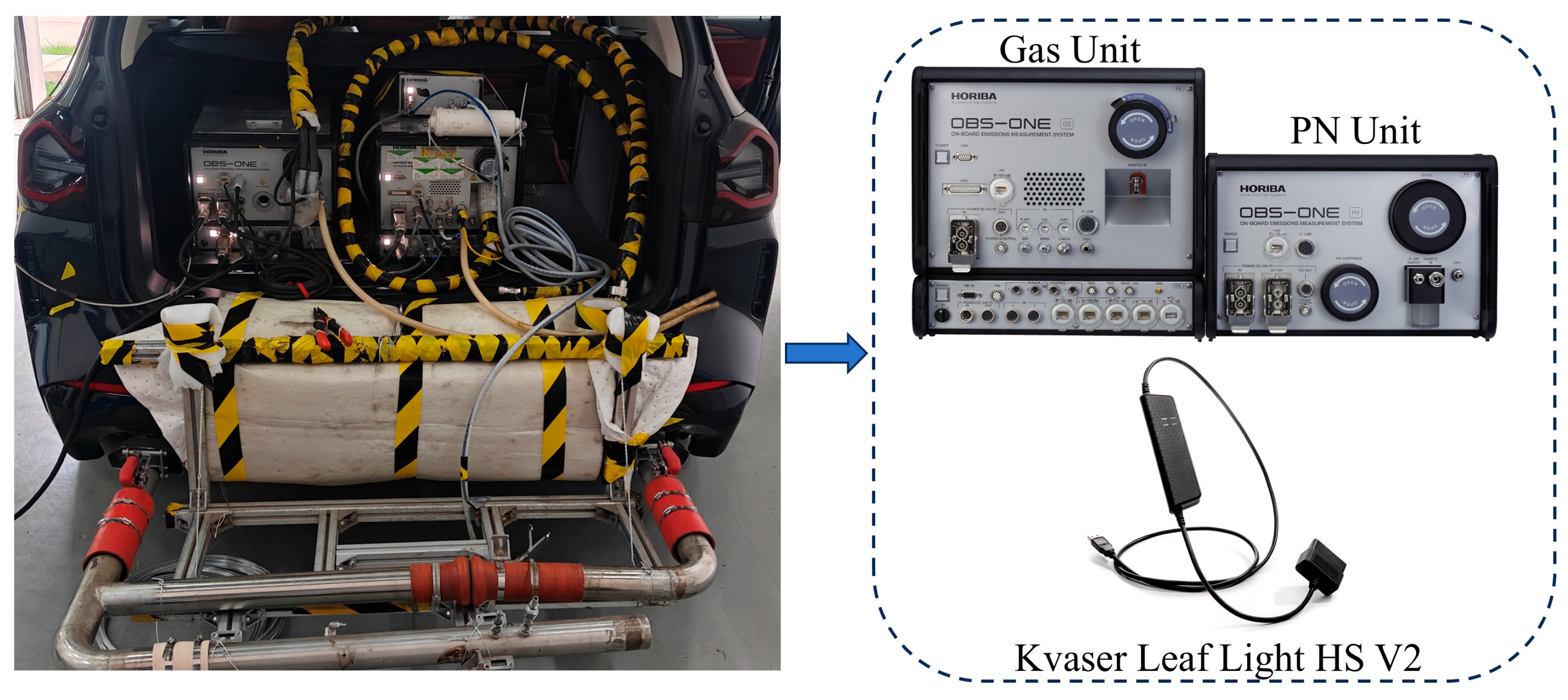

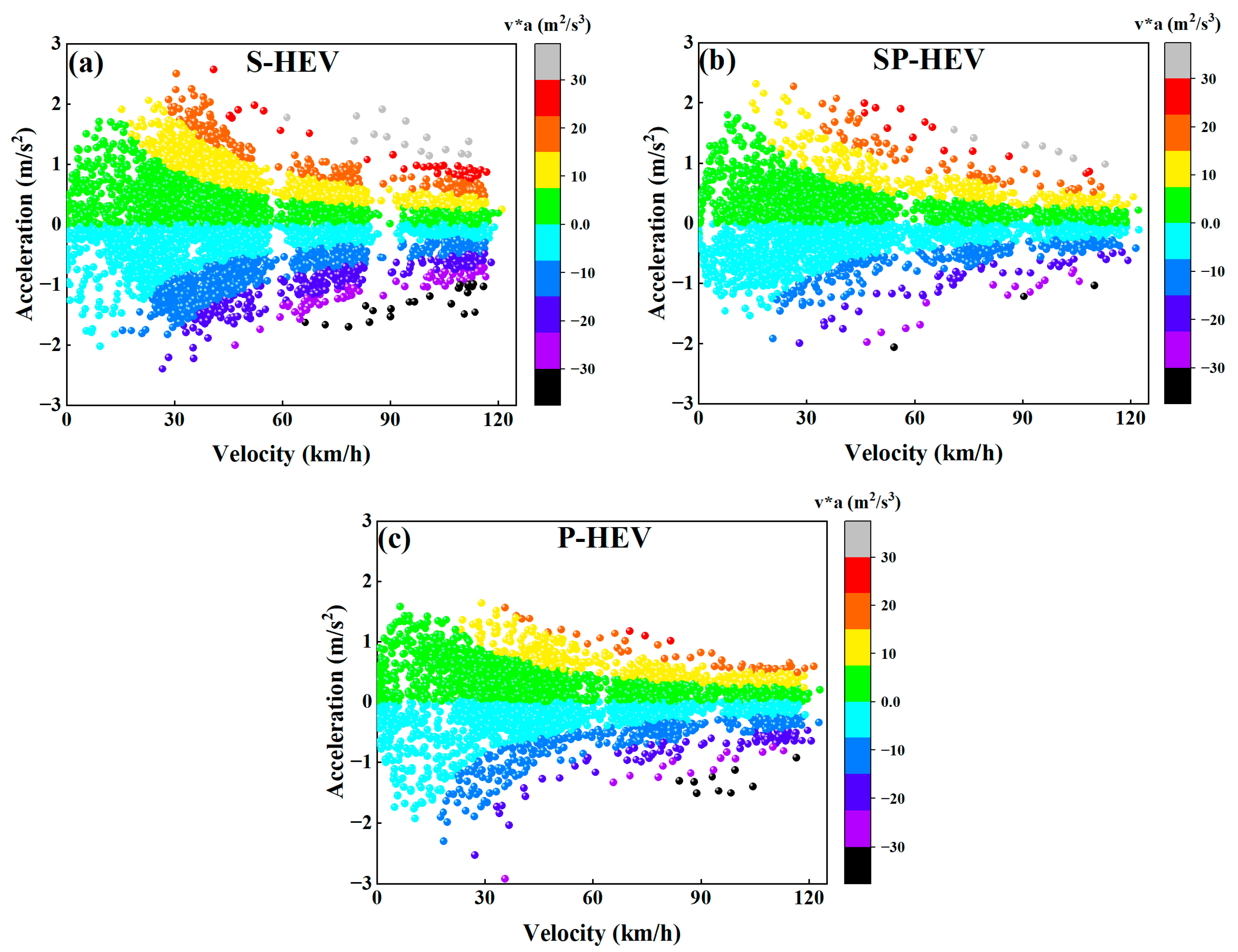
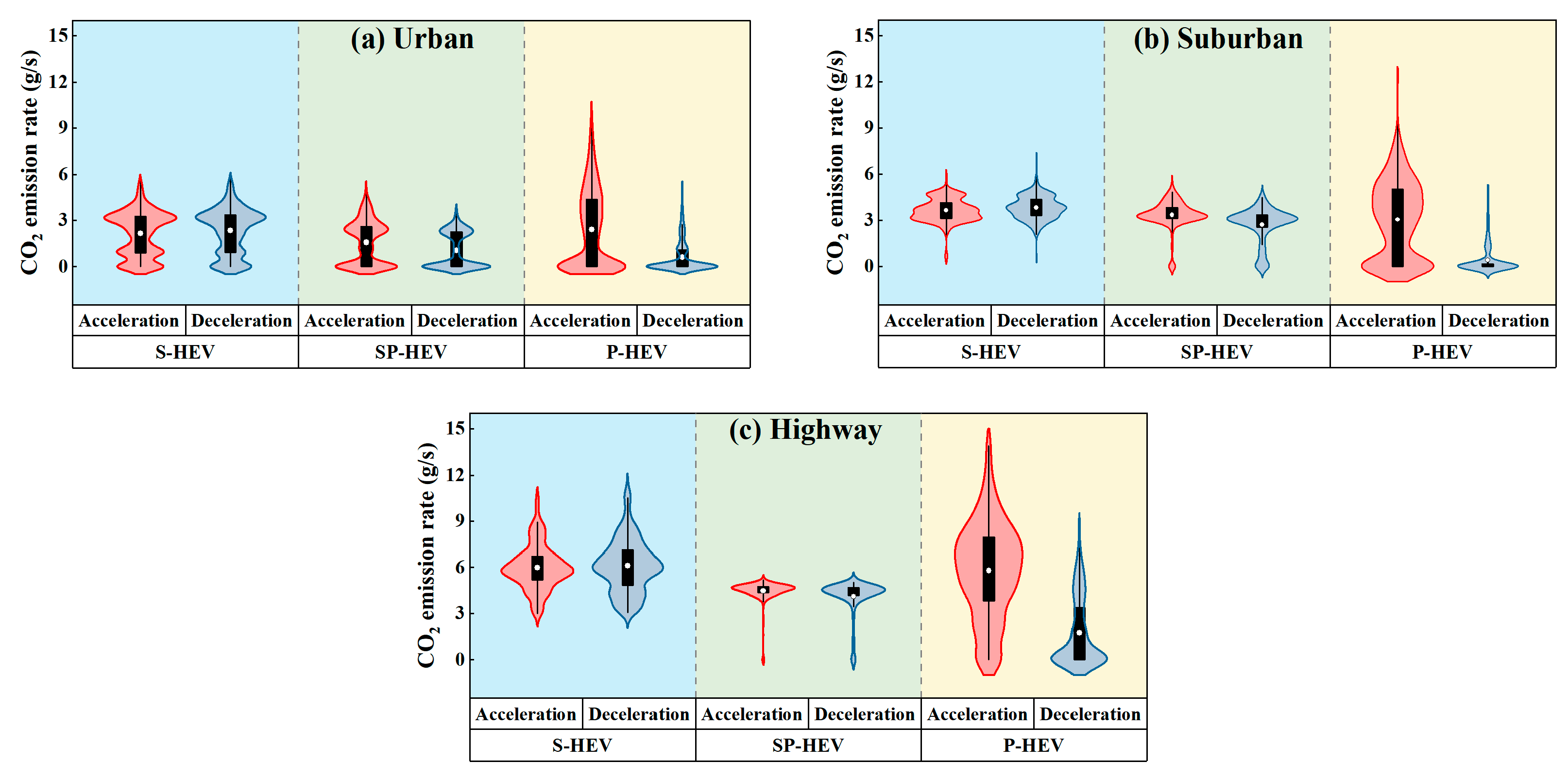


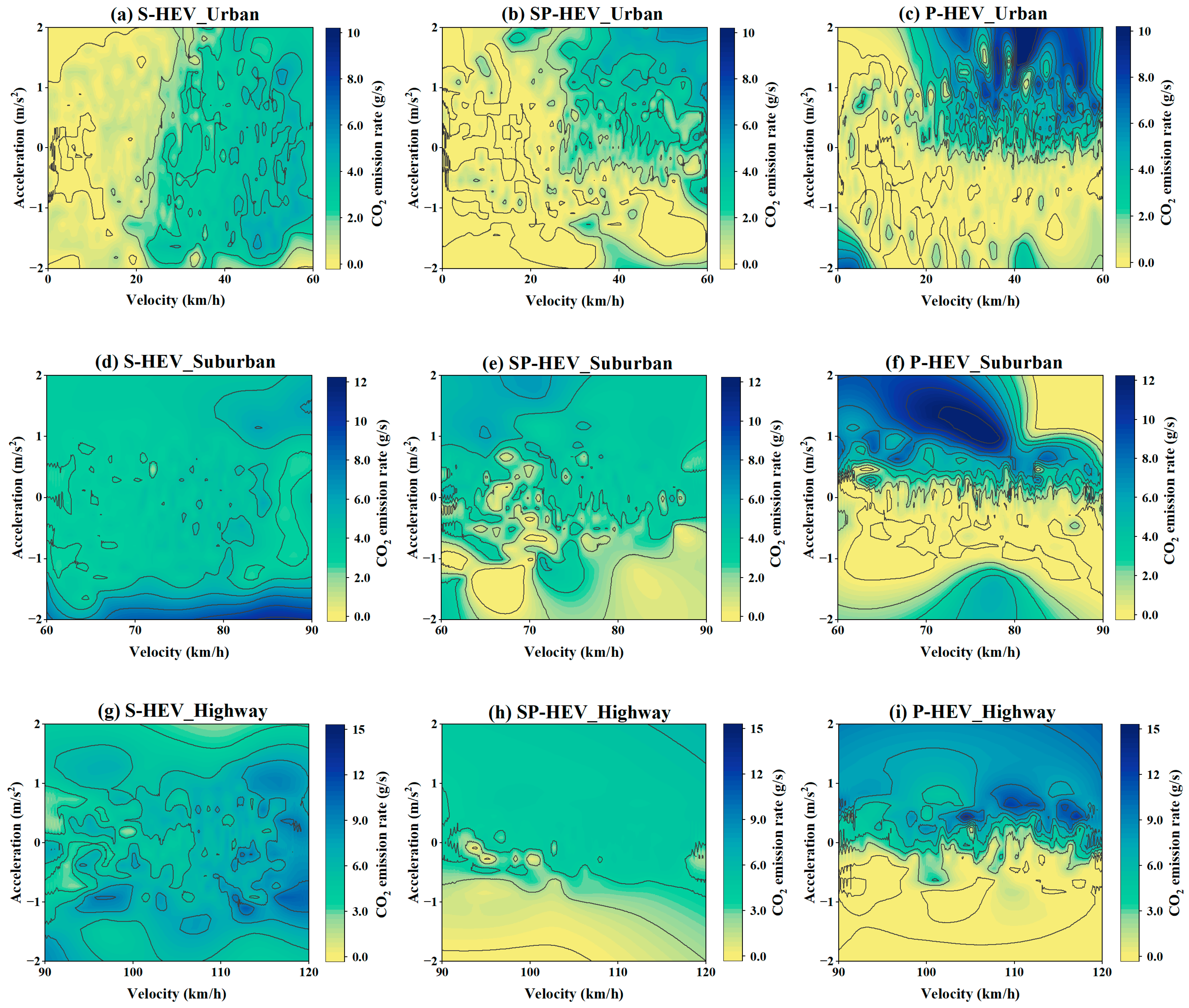
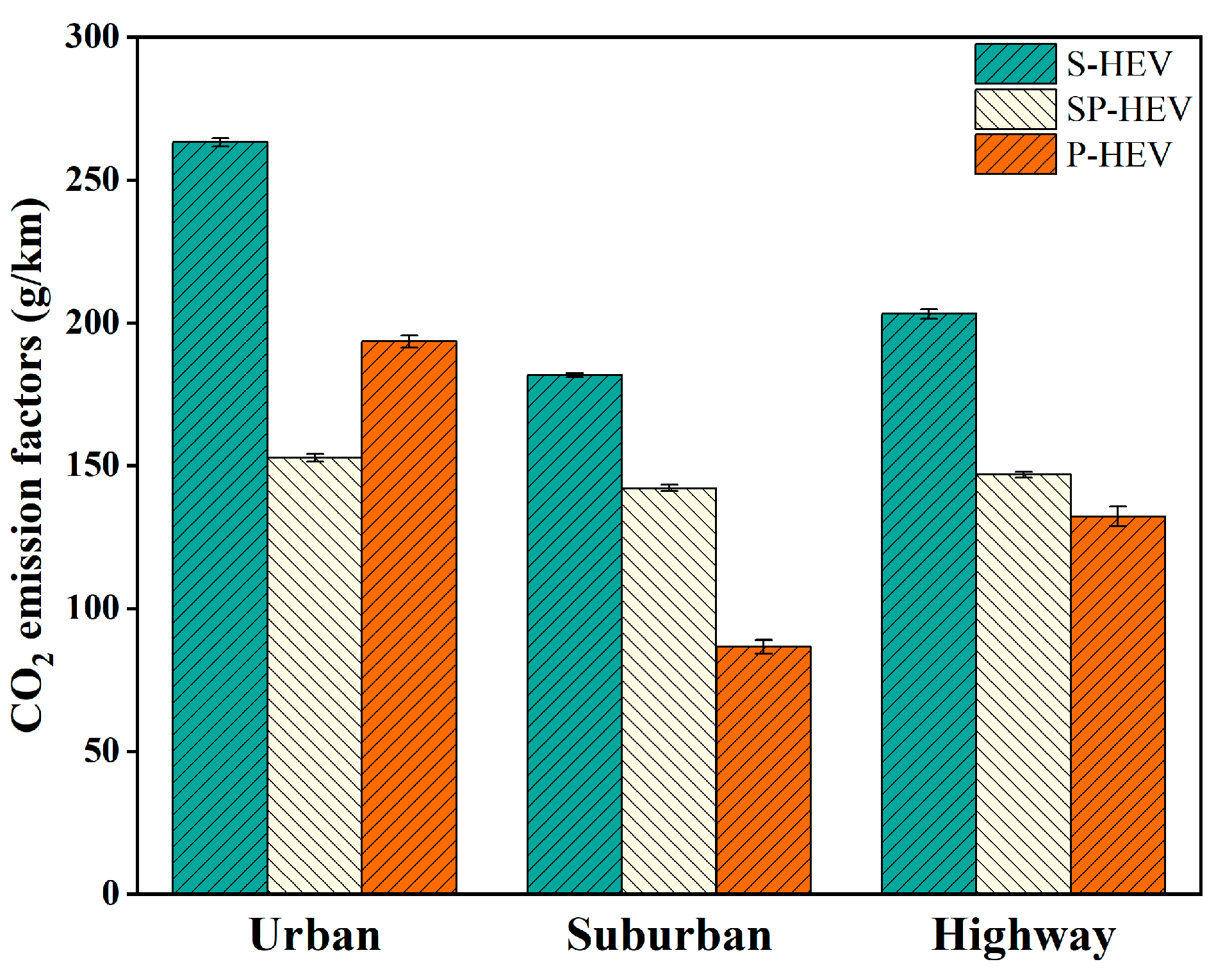
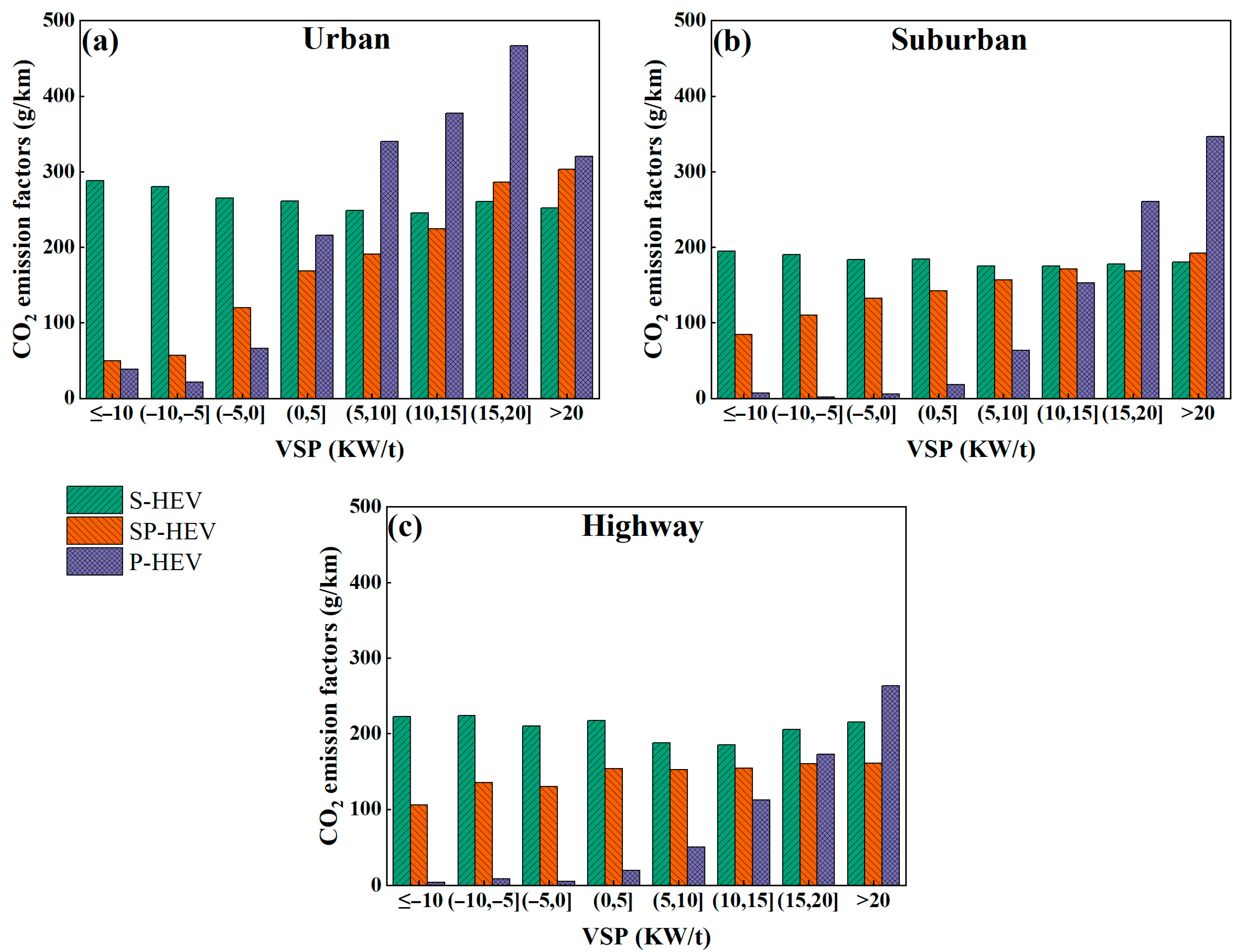
| Parameter | S-HEV | SP-HEV | P-HEV |
|---|---|---|---|
| Model Year | July 2023 | February 2024 | December 2021 |
| Emission Standard | China Ⅵ | China Ⅵ | China Ⅵ |
| Curb Weight/(kg) | 2220 | 2047 | 1750 |
| Displacement/(L) | 1.5 | 1.5 | 1.4 |
| Intake Type | Turbocharging | Turbocharging | Turbocharging |
| Fuel Delivery System | Multi-point injection | Direct injection | Direct injection |
| Fuel Type | Gasoline | Gasoline | Gasoline |
| Octane Rating Research Octane Number | 95 | 92 | 95 |
| ICE Maximum Power/(kW) | 112 | 102 | 110 |
| ICE Maximum Torque/(N.m) | 205 | 231 | 250 |
| Electric Motor Power(kW) | 200 | 145 | 85 |
| Total Torque of Electric Motor (N.m) | 360 | 316 | 330 |
| Total Horsepower of the Motor (ps) | 272 | 197 | 116 |
| Electric Motors | Single motor | Single motor | Single motor |
| Battery Power (kWh) | 42 | 18.3 | 13 |
| Battery Cooling Method | Liquid cooling | Liquid cooling | -- |
Disclaimer/Publisher’s Note: The statements, opinions and data contained in all publications are solely those of the individual author(s) and contributor(s) and not of MDPI and/or the editor(s). MDPI and/or the editor(s) disclaim responsibility for any injury to people or property resulting from any ideas, methods, instructions or products referred to in the content. |
© 2025 by the authors. Licensee MDPI, Basel, Switzerland. This article is an open access article distributed under the terms and conditions of the Creative Commons Attribution (CC BY) license (https://creativecommons.org/licenses/by/4.0/).
Share and Cite
Yang, N.; Lian, X.; Bai, Z.; Rao, L.; Jiang, J.; Li, J.; Wang, J.; Wang, X. Characterizing CO2 Emission from Various PHEVs Under Charge-Depleting Conditions. Atmosphere 2025, 16, 946. https://doi.org/10.3390/atmos16080946
Yang N, Lian X, Bai Z, Rao L, Jiang J, Li J, Wang J, Wang X. Characterizing CO2 Emission from Various PHEVs Under Charge-Depleting Conditions. Atmosphere. 2025; 16(8):946. https://doi.org/10.3390/atmos16080946
Chicago/Turabian StyleYang, Nan, Xuetong Lian, Zhenxiao Bai, Liangwu Rao, Junxin Jiang, Jiaqiang Li, Jiguang Wang, and Xin Wang. 2025. "Characterizing CO2 Emission from Various PHEVs Under Charge-Depleting Conditions" Atmosphere 16, no. 8: 946. https://doi.org/10.3390/atmos16080946
APA StyleYang, N., Lian, X., Bai, Z., Rao, L., Jiang, J., Li, J., Wang, J., & Wang, X. (2025). Characterizing CO2 Emission from Various PHEVs Under Charge-Depleting Conditions. Atmosphere, 16(8), 946. https://doi.org/10.3390/atmos16080946







